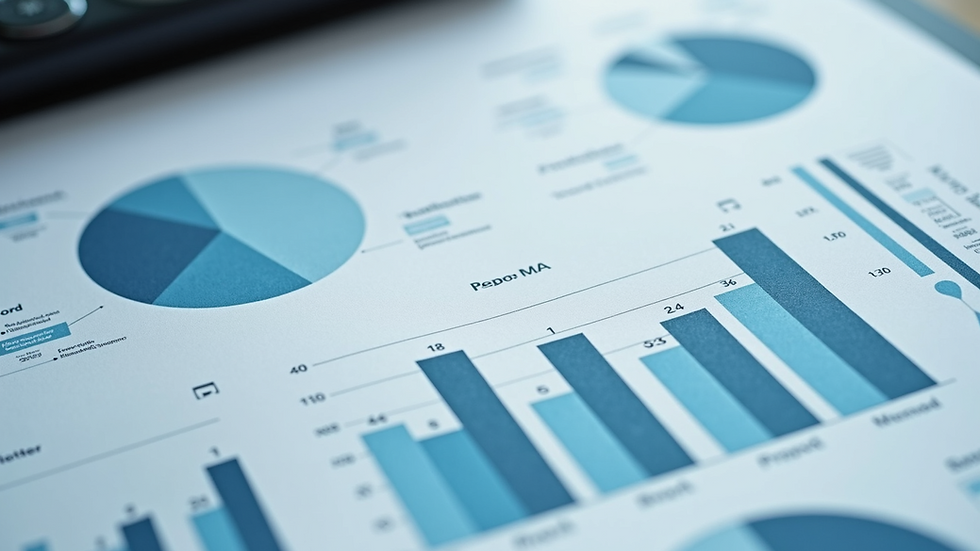How Economic Analysis Reports Shape Financial Strategies
- Achille Ekeu, MBA, CVA

- Aug 24
- 3 min read

Economic analysis reports play a crucial role in shaping financial strategies for businesses, investors, and policymakers. These reports provide detailed insights into economic trends, market conditions, and financial indicators that help decision-makers craft informed strategies. Understanding how to interpret and apply the data from these reports can lead to better financial outcomes and more resilient business models.
The Role of Economic Analysis in Financial Planning
Economic analysis is the process of examining economic data to understand the current state and future outlook of an economy or market. This analysis helps businesses and investors anticipate changes, identify opportunities, and mitigate risks. Financial planning that incorporates economic analysis is more adaptive and responsive to external factors.
For example, a company planning to expand its operations might use economic analysis to evaluate the potential demand in new markets. By understanding factors such as consumer spending, employment rates, and inflation, the company can decide where and when to invest. Similarly, investors use economic analysis to adjust their portfolios based on expected economic cycles.
Key benefits of integrating economic analysis into financial planning include:
Improved risk management: Identifying economic downturns early helps in adjusting strategies to minimize losses.
Optimized resource allocation: Directing funds to sectors or regions with strong economic growth potential.
Enhanced forecasting accuracy: Using economic indicators to predict market trends and consumer behavior.
Understanding Economic Analysis Reports
Economic analysis reports are comprehensive documents that summarize economic data and provide interpretations of trends and forecasts. These reports are often produced by government agencies, financial institutions, and research organizations. One notable source is the bureau of economic analysis reports, which offer detailed statistics on GDP, consumer spending, and other vital economic indicators.
These reports typically include:
Macroeconomic indicators: GDP growth rates, unemployment figures, inflation rates.
Sector-specific data: Performance of industries such as manufacturing, services, and agriculture.
Regional analysis: Economic conditions in different states or metropolitan areas.
Forecasts and projections: Predictions about future economic performance based on current data.
By studying these reports, financial strategists can gain a clearer picture of the economic environment. For instance, if a report indicates rising inflation, a business might consider adjusting pricing strategies or hedging against cost increases.

What is an Economic Analysis Report?
An economic analysis report is a detailed document that evaluates economic conditions using quantitative data and qualitative insights. It serves as a tool for understanding how various economic factors interact and influence markets and financial outcomes.
These reports are essential for:
Policy formulation: Governments use them to design fiscal and monetary policies.
Investment decisions: Investors analyze them to identify profitable opportunities and avoid risks.
Business strategy: Companies rely on them to plan expansions, product launches, and cost management.
A typical economic analysis report includes sections such as:
Executive summary: A brief overview of key findings.
Economic overview: Description of the current economic climate.
Data analysis: Detailed examination of economic indicators.
Implications: How the data affects markets and businesses.
Recommendations: Suggested actions based on the analysis.
For example, a report might highlight a slowdown in consumer spending, prompting retailers to focus on cost control and inventory management.

Practical Applications of Economic Analysis in Financial Strategies
Incorporating economic analysis into financial strategies involves several practical steps:
Regular monitoring: Continuously review economic reports to stay updated on market conditions.
Scenario planning: Develop multiple financial plans based on different economic scenarios (e.g., recession, growth).
Diversification: Use economic insights to diversify investments across sectors and regions.
Cost management: Adjust budgets and expenses in response to inflation or supply chain disruptions.
Capital allocation: Prioritize investments in areas with strong economic indicators.
For instance, during periods of economic growth, companies might increase capital expenditures to expand capacity. Conversely, in a downturn, they may focus on liquidity and cost reduction.
Financial managers should also consider external factors such as geopolitical events and technological changes that can influence economic trends. Combining economic analysis with these factors leads to more robust financial strategies.
Enhancing Decision-Making with Economic Analysis Reports
Economic analysis reports provide a foundation for making informed financial decisions. To maximize their value:
Interpret data contextually: Understand the broader economic environment and how it affects specific industries.
Use multiple sources: Compare reports from different agencies and institutions for a balanced view.
Engage experts: Consult economists or financial analysts to interpret complex data.
Integrate with business intelligence: Combine economic data with internal company data for comprehensive analysis.
By doing so, businesses can anticipate market shifts, optimize investment timing, and improve overall financial performance.
Economic analysis reports are indispensable tools that shape effective financial strategies. By leveraging the insights they provide, businesses and investors can navigate economic uncertainties with greater confidence and agility. Staying informed and proactive in response to economic data is key to long-term financial success.




Comments